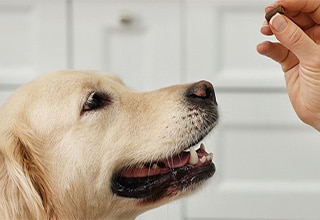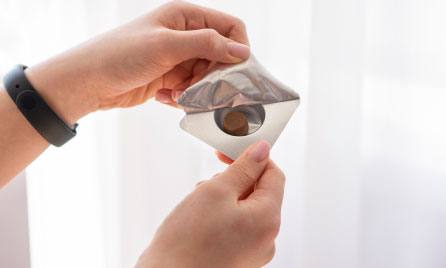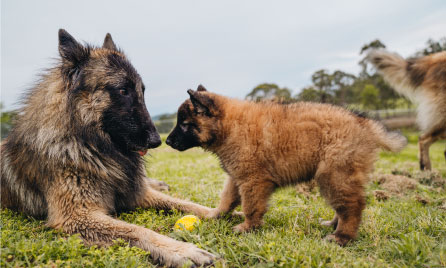- text
-
* Limits, waiting periods, exclusions and excesses may apply.
Worming your dog or puppy.
Parasites can be a worrying concern for pet parents. They could be common in our environment and might have serious health implications for us, as well as our dogs.
Fortunately, there’s a large range of deworming products available. Here’s some information on how to use those products to help keep our dogs safe, healthy and parasite-free.
How often you should worm your dog depends on your dog’s age. Adult dogs generally need deworming at least every three months. However, this might need to be done more often depending on your dog’s health and your living environment.
How do dogs get worms?
Here are some ways dogs can get worms:
Ingesting contaminated soil, or another animal's faeces containing worm eggs.
Ingesting contaminated meat.
Eating an infected flea.
Heartworm larvae transmitted by infected mosquitoes.
Larvae passing through the skin.
Puppies can be infested with worms in utero before birth, or by drinking contaminated mother's milk in the first few weeks of life.
Worming medication usually kill the worms present at the time of intake, acting as a short term medication. Since there are many ways dogs can pick up worms, it’s important to deworm them on a regular basis.
Types of worms
There are 6 main types of worms that can affect dogs’s health:
1. Roundworm
Roundworm infestation can occur from eating soil containing eggs, in utero, from their mother’s milk or from contaminated meat. Roundworms can also cause serious health issues in humans, specially children, including blindness.
If your dog is infested with roundworm, some of the symptoms are diarrohea, vomiting, overall poor condition and pot belly.
2. Hookworm
Dogs can become infected with hookworm by eating contaminated soil or meat, from a puppy's mother in utero or via her milk, or even via the larvae directly entering the skin. Hookworms can be potentially deadly to puppies, causing anaemia and even death.
Some symptoms of hookworm infestation are diarrhoea with blood, poor growth and potbellied appearance.
3. Whipworm
Dogs can get whipworm from eating contaminated soil. Its eggs can survive in the environment for up to five years. Some symptoms of whipworm infestation are severe bloody diarrhoea, weight loss and anaemia.
4. Tapeworm
Tapeworm can be quite common in dogs, usually transmitted by ingesting an infected flea.
It can be diagnosed by little segments of tapeworm on a dog's bottom, causing them to scoot their bottom along the ground, bitting at it and weight loss.
5. Hydatid Tapeworm
Hydatid Tapeworm can have a high risk to human health. Dogs can get infected by consuming raw meat, usually sheep or kangaroo. Infected dogs tend to show no clinical signs, but can infect humans, who can develop severe illness that might require invasive surgery.
6. Heartworm
Heartworm can be transmitted by an infected mosquito biting your dog. Heartworm infestation can cause blockages in the heart, lethargy, general poor condition, coughing and even heart failure.
How do I know if my dog has worms?
There are several signs that can indicate your dog has worms. However, they can also be infested and show no signs at all.
Some common signs from worm infestation are:
- Diarrhoea, sometimes with blood
- Pale gums or anaemia
- Poor growth
- Lethargy
- Vomit
- Scooting and biting at bottom
- Worms in poo, or visible worm segments on bottom
- Dull coat
- Pot belly
- Weight loss
If you are concerned about your dog’s health, your vet can help diagnose and recommend the right treatment for any potential worm infestation.
What kind of dog worming medicine should I use?
There are several options when it comes to worming dogs, such as tablets, spot on products, chews and syrups. Each of them cover a different combination of parasites, as well as different dosing frequency.
When choosing any kind of worm medicine, it’s essential to know your dog’s weight, as the dosage will depend on it.
It’s important to make sure that, regardless of the product you choose, your dog is:
Protected against heartworm with a monthly chew, tablet, spot on or annual injection.
Protected against roundworm, hookworm, whipworm and tapeworm.
Wormed at least every 6 weeks if there’s any risk of hydatid tapeworm. If there’s no risk, your dog can be wormed every 6 months against roundworm, hookworm, whipworm, and tapeworm.
It can be beneficial to discuss your dog’s worm management with your vet as it might change based on individual needs as well as environmental considerations.
Why pick Everyday Pet Insurance?
Get a quote for your pet in minutes.
Related articles.
- text
-
# Policy Terms and Conditions, exclusions and limits apply. Benefit limit amounts vary by level of cover.
- text
-
‡ Cover is available for the life of your pet provided you renew your policy each year without any break, lapse or change in the level of Cover. This means once your pet is insured with us and as long as we continue to offer the product, you will be able to renew your policy for that pet for life and your cover level will not be reduced as your pet ages provided you continuously maintain the cover. Cover is subject to the terms and conditions of your renewing policy. See details in your PDS.
- text
-
= The gap is defined as the difference between the vet's invoice and the claim benefit under your policy. Policy terms and conditions apply. GapOnly® is only available at participating Vets. Please visit GapOnly® to search for GapOnly® enabled vets. GapOnly® is a trademark owned by PetSure (Australia) Pty Ltd (PetSure) (ABN 95 075 949 923, AFSL 420183).
- text
-
Everyday Pet Insurance policies entered into for the first time prior to 17 July 2023 and subsequent renewals of those policies are issued by The Hollard Insurance Company Pty Ltd ABN 78 090 584 473, AFSL 241436 (Hollard), arranged and administered by PetSure (Australia) Pty Ltd ABN 95 075 949 923, AFSL 420183 (PetSure) and promoted and distributed by Hollard’s Authorised Representative (AR) Woolworths Group Limited ABN 88 000 014 675, AR 245476 (Woolworths). Everyday Pet Insurance policies entered into for the first time on or after 17 July 2023 and subsequent renewals of those policies are issued by PetSure and promoted and distributed by PetSure’s AR, Woolworths. Any advice provided is general only and does not take into account your individual objectives, financial situation or needs. Please consider the Product Disclosure Statement (PDS) to ensure this product meets your needs before purchasing, or choosing to continue with the product. PDS and Target Market Determination available at insurance.everyday.com.au/pet-insurance.










